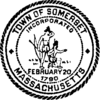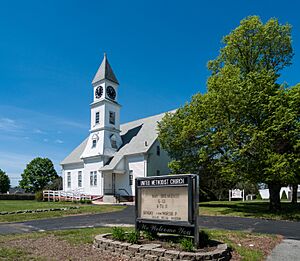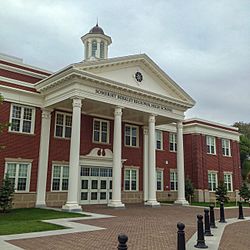Somerset, Massachusetts facts for kids
Quick facts for kids
Somerset, Massachusetts
|
||
|---|---|---|
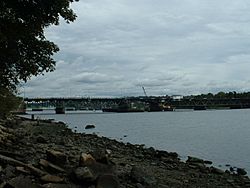
Brightman Street Bridge, taken from the Somerset side of the Taunton River
|
||
|
||
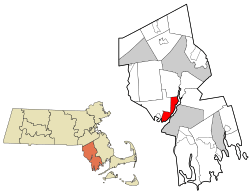
Location in Bristol County in Massachusetts
|
||
| Country | United States | |
| State | Massachusetts | |
| County | Bristol | |
| Settled | 1677 | |
| Incorporated | 1790 | |
| Government | ||
| • Type | Open town meeting | |
| Area | ||
| • Total | 12.0 sq mi (31.0 km2) | |
| • Land | 8.1 sq mi (21.0 km2) | |
| • Water | 3.9 sq mi (10.0 km2) | |
| Elevation | 50 ft (15 m) | |
| Population
(2020)
|
||
| • Total | 18,303 | |
| • Density | 1,525/sq mi (590.4/km2) | |
| Time zone | UTC-5 (Eastern) | |
| • Summer (DST) | UTC-4 (Eastern) | |
| ZIP Codes |
02725, 02726
|
|
| Area code(s) | 508/774 | |
| FIPS code | 25-62430 | |
| GNIS feature ID | 0619438 | |
| Website | www.townofsomerset.org | |
Somerset is a town in Bristol County, Massachusetts, USA. About 18,300 people lived there in 2020. It's famous as the hometown of Clifford Milburn Holland, who was the main engineer for the Holland Tunnel in New York City.
Somerset is part of the South Coast area of Massachusetts. This region includes towns around Buzzards Bay, Mount Hope Bay, and the Sakonnet River.
Contents
History of Somerset
Somerset was first settled in 1677 on land called Shawomet. It officially became a town in 1790. The town was named after Somerset Square in Boston, which got its name from the county of Somerset in England.
Long ago, Somerset was a very important place for shipping goods. After the War of 1812, it became one of America's main places for distributing products. In 1872, it became a big coal port. In the early 1900s, there was also a large factory that canned food.
However, as the nearby city of Fall River grew, it took over much of Somerset's business. Somerset then became more of a suburban town, meaning people lived there and often worked in bigger cities nearby. During the Great Depression, more people moved to Somerset from Fall River and other places.
Today, Somerset's main industry is making electricity. The Montaup Electric Company plant opened in 1923. The Brayton Point Power Station started in 1963. Brayton Point used to burn coal, which caused pollution problems. It closed on May 31, 2017.
Bridges and Connections
Somerset and Fall River have always been connected. In the late 1700s, a ferry called Slade's Ferry carried people across the Taunton River. Later, the Slade's Ferry Bridge connected the two towns. This bridge had two levels, with a railroad on the top. It closed in 1970 because it was old and too low for ships.
The Brightman Street Bridge opened in 1908, just north of the old ferry. A newer bridge, the Veterans Memorial Bridge, opened in 2011. Now, both sides of this bridge are open for traffic.
Geography and Location
Somerset is located at 41°44′54″N 71°9′11″W. The town covers about 12 square miles (31 square kilometers). About 8.1 square miles (21 square kilometers) is land, and 3.9 square miles (10 square kilometers) is water. It is next to Mount Hope Bay and Narragansett Bay. The Taunton River forms its eastern border.
Somerset shares borders with Swansea to the west and Dighton to the north. Across the Taunton River to the east is Fall River. To the south, it borders Bristol, Rhode Island, in the middle of the bay.
Nearby cities include Fall River, New Bedford, and Providence. Somerset is about an hour's drive south of Boston.
Getting Around Somerset
Interstate 195 goes through Somerset. It crosses the Braga Bridge from Fall River. There is an exit for Route 103.
The Veterans Memorial Bridge carries U.S. Route 6 and Route 138 across the river. Route 6 goes east-west and has many shopping areas. Route 138 goes north from the bridge along County Street, which is the town's main north-south road.
Buses run along Route 6, provided by the Southeastern Regional Transit Authority (SRTA). The closest train service is in Providence, Rhode Island. There are plans to bring commuter train service to Fall River by 2023, which would connect Somerset to Boston by rail.
The closest regional airport is in New Bedford, about 18 miles away. The closest national airport is T. F. Green Airport in Rhode Island, about 27 miles away. For international flights, Logan International Airport in Boston is about 55 miles away.
Population and People
| Historical population | ||
|---|---|---|
| Year | Pop. | ±% |
| 1850 | 1,166 | — |
| 1860 | 1,793 | +53.8% |
| 1870 | 1,776 | −0.9% |
| 1880 | 2,006 | +13.0% |
| 1890 | 2,106 | +5.0% |
| 1900 | 2,241 | +6.4% |
| 1910 | 2,798 | +24.9% |
| 1920 | 3,520 | +25.8% |
| 1930 | 5,398 | +53.4% |
| 1940 | 5,873 | +8.8% |
| 1950 | 8,566 | +45.9% |
| 1960 | 12,196 | +42.4% |
| 1970 | 18,088 | +48.3% |
| 1980 | 18,813 | +4.0% |
| 1990 | 17,655 | −6.2% |
| 2000 | 18,234 | +3.3% |
| 2010 | 18,165 | −0.4% |
| 2020 | 18,303 | +0.8% |
| 2022 | 18,192 | −0.6% |
Source: United States Census records and Population Estimates Program data. |
||
In 2000, there were 18,234 people living in Somerset. Most people (98.22%) were White. About 28.1% of homes had children under 18. Most homes (62.4%) were married couples.
The average age in town was 43 years old. About 20.4% of the population was under 18. The median income for a household was $51,770. This means half of the households earned more than this, and half earned less.
Education in Somerset
Somerset has its own public school system. There are three elementary schools: North Elementary School, Chace Street School, and South Elementary School. Somerset Middle School is next to South Elementary and teaches grades 6 to 8.
Somerset Berkley Regional High School is on County Street (Route 138). The school's mascot is the "Blue Raider," and its colors are dark blue and white. Two famous baseball players, Greg Gagne and Jerry Remy, went to this high school.
Students can also go to Diman Regional Vocational Technical High School in Fall River. Another option is Bristol County Agricultural High School in Dighton. There are no private schools in Somerset, but many students attend private schools in Fall River, like Bishop Connolly High School.
New High School Building
A new regional school building opened in August 2014. It was built behind the old high school. The football field and running track were also updated. The old high school building was taken down in late 2014, and new sports fields were built where it used to be.
Notable People from Somerset
- Beatrice Arbour, All-American Girls Professional Baseball League player
- Pamela Bustin, 1996 Olympic field hockey player
- Alan Chebot, Television producer and director
- Alice DeCambra, All-American Girls Professional Baseball League player
- Lillian DeCambra, All-American Girls Professional Baseball League player
- Shirley May France, tried to swim the English Channel in 1949 and 1950
- Greg Gagne, Major League Baseball shortstop for two Minnesota Twins world championship teams
- Leslie Marshall, journalist
- Clifford Milburn Holland, chief engineer and namesake of the Holland Tunnel in New York City
- Rhoda Leonard, All-American Girls Professional Baseball League player
- Nancy Pimental, actress and screenwriter for the film The Sweetest Thing
- Stephen Rebello, writer and screenwriter known for books like Alfred Hitchcock and the Making of Psycho
- Jerry Remy, Major League Baseball second baseman for the California Angels and Boston Red Sox; longtime Red Sox color commentator for NESN
- Janet L. Robinson, former president and CEO of The New York Times
See also
 In Spanish: Somerset (Massachusetts) para niños
In Spanish: Somerset (Massachusetts) para niños


